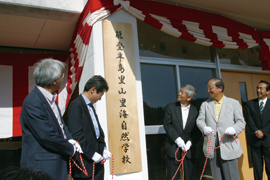The Mitsui & Co. Environment Fund
Introduction to Grant Projects
Kanazawa University Center for Regional Collaboration Satoyama Project (draft participation by Mitsui & Co. Hokuriku Branch)
Establishment of "Satoyama Satomi Nature School," Noto Peninsula
Activity grant
- Project Description
Activities for regional revitalization by conservation and restoration of Satoyama in the Noto Peninsula, Ishikawa prefecture, an area deteriorating due to depopulation and aging population. Kanazawa University, which has demonstrated outcomes in managing nature schools, established the network organization "Satoyama Satomi Nature School," with the aim of conservation and restoration of Satoyama and Satomi in the Noto region and revitalizing agriculture, forestry and fisheries, in collaboration with regional leaders, agriculture/forestry/fisheries workers, company workers, and others. Holds a wide scope of lectures and symposiums, and conducts surveys and interactive activities in the outdoors, to foster human resources. Mitsui & Co. Hokuriku Branch Office, in addition to approving activity principles and participating in the drafting of plans and management, participates in conservation activities including those by employees and families of Mitsui Group corporations.
- Fields
- Preservation of biodiversity and ecosystem
- Grant year
- FY2006 Activity Grants
- Grant term
- 3 years
July 2006 - June 2009
- Grant amount
- 26,000,000 yen
- Activity region
- Two cities and two towns of Oku-noto centered on Suzu, Ishikawa Prefecture

Overview of the Organization

- Representative
- Koji Nakamura, Professor/Satoyama Project Supervising Researcher
- Established
- 1999
- Establishment Purpose
- Kanazawa University aims to be "open to the local community" and "a hub of regional knowledge" in line with its mission of contributing to society alongside its education and research activities. To realize these objective, The Center for Regional Collaboration administers "Kanazawa University Kakuma no Satoyama Nature School," aiming to embody a flexible and broad-minded "University-like" presence, playing a "role which could only be fulfilled by a university." In addition, along with using educational and research outcomes in activities, they will utilize activity outcomes from the region in education and research. Activities will not be limited to the Kakuma Campus, but will also be deployed in the Noto Peninsula, etc.
- Main activity regions
- Ishikawa Prefecture, with a focus on Kanazawa University Kakuma Campus in Kanazawa City, Ishikawa.
- Staff
- 2 full-time staff members, 11 part-time staff members
- Annual operating budget
- 50 million yen in 2005, 60 million yen in 2006, 110 million yen in 2007
- Main recent activities
- Since its initial establishment, the organization has maintained Satoyama conservation activities for the university campus alongside students and regional residents. Since the 2005 instigation of "Nature Symbiotic Regional Planning around the core of "Kanazawa University Kakuma no Satoyama Nature School"" it has conducted social actions on the Satoyama issues of Ishikawa Prefecture including Noto and educational research on regional issues. In addition, it has collated on-site information relating to Satoyama, and endeavored to further mutual exchange by surveys, research and education of the university alongside the "Satoyama Chumura Reaserchers" (41 persons appointed by Kanazawa University in 2005 to tackle conservation and restoration, etc. of Satoyama Satomi in the region). Further, it has also administered the "Noto Satoyama Master Fostering Program" since 2007, following the establishment of the "Noto Peninsula Satoyama Satomi Nature School" in Oku-noto/Suzu City since 2006, and is here engaged with conservation and renewal projects for Oku-noto.